Limited To One Tree? These 15 Self-Fertile Apple Tree Types Will Fruit On Their Own

FRUIT > APPLES > VARIETIES > SELF-POLLINATING

Elizabeth is a Permaculture Garden Designer, Sustainability Consultant and Professional Writer, working as an advocate for positive change. She graduated from the University of St. Andrews with an MA in English and Philosophy and obtained a Diploma in Applied Permaculture Design from the Permaculture Association.
Reviewed By COLIN SKELLY

Colin is a Horticulturist and Horticultural Consultant with experience in a range of practical and managerial roles across heritage, commercial and public horticulture. He holds the Royal Horticultural Society’s Master of Horticulture award and has a particular interest in horticultural ecology and naturalistic planting for habitat and climate resilience.
IN THIS GUIDE
- Are Apple Trees Self-Pollinating?
- 1) M. domestica ‘Egremont Russet’
- 2) M. domestica ‘Ellison’s Orange’
- 3) M. domestica ‘Greensleeves’
- 4) M. domestica ‘James Grieve’
- 5) M. domestica ‘King Of The Pippins’
- 6) M. domestica ‘Lane’s Prince Albert’
- 7) M. domestica ‘Laxton’s Superb’
- 8) M. domestica ‘Red Devil’
- 9) M. domestica ‘Red Falstaff’
- 10) M. domestica ‘Red Windsor’
- 11) M. domestica ‘Reverend W. Wilks’
- 12) M. domestica ‘Scrumptious’
- 13) M. domestica ‘Spartan’
- 14) M. domestica ‘Sunset’
- 15) M. domestica ‘Winston’
- References
One of the important things to look at when choosing an apple tree, or any fruit tree for that matter, is whether or not it will fruit best with a pollination partner or can be grown as a self-fertile specimen.
When we talk about a self-pollinating or self-fertile fruit tree, we are talking about a tree that produces fruit even without the presence of another suitable tree for pollination.
A self-pollinating tree has both the male and the female parts on the same plant and does not require another compatible tree to be in blossom at the same time.
Are Apple Trees Self-Pollinating?
Fortunately, many apple trees do fall into the self-fertile or self-pollinating category.
This is useful for those who only have enough space for a single apple tree in their garden.
However, it is important to note that not all apple tree varieties are entirely self-pollinating.
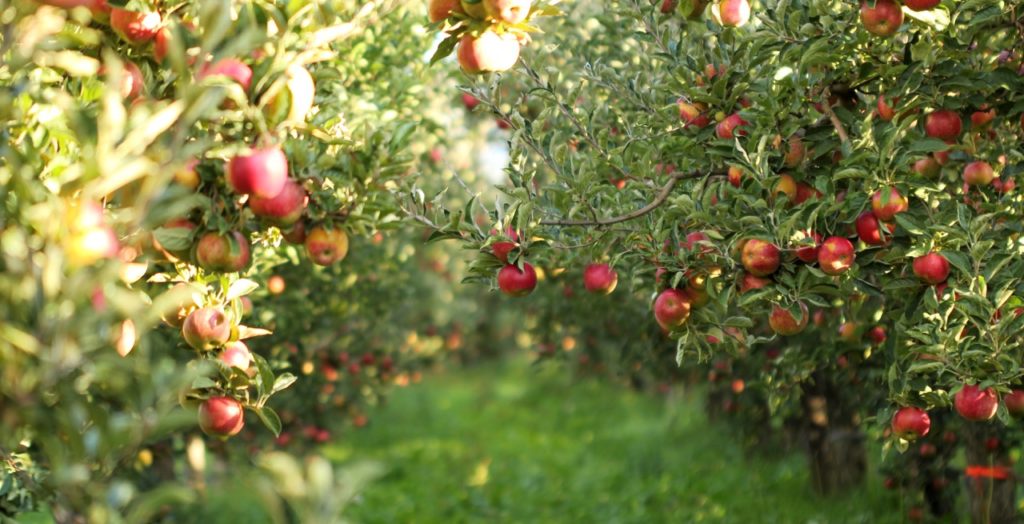
Some are only partially self-fertile, and though they can fruit on their own, they will fruit better when there is another suitable apple tree in the right pollination group close by.
For those who can only grow a single apple tree, here are some of the best self-pollinating varieties to consider.
All of the plants in this list can be grown in most soil conditions with a neutral pH and are fully UK-hardy.
1) M. domestica ‘Egremont Russet’
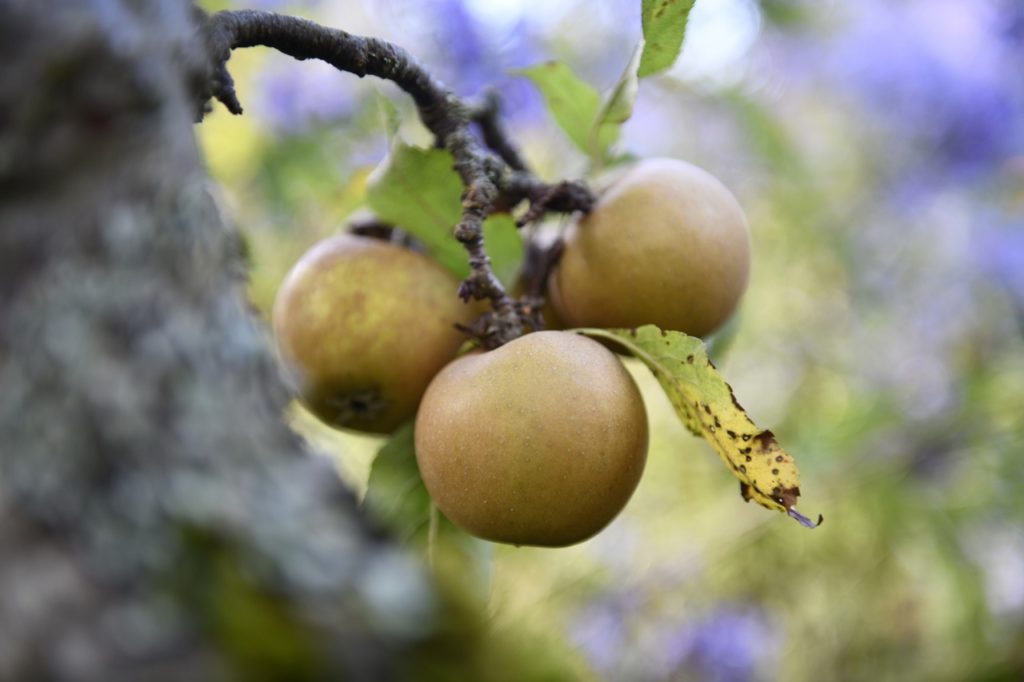
- COMMON NAME(S): apple ‘Egremont russet’
- FLOWERS: pink
- FRUIT: yellow and green
- SIZE: 1.5-2m in height, 1.5-2.5m spread
This popular apple variety originated in Sussex in around 1872 and is still as popular today as it was during Victorian times.1May, P. (n.d.). A Guide to Sussex Apple Varieties. A Guide to Sussex Apple Varieties. Retrieved March 9, 2023, from https://brightonpermaculture.org.uk/wp-content/uploads/fruit/sussex-apple-varieties.pdf
It is an eating or dessert apple with crisp flesh and a sweet, nutty flavour.
I started with one apple in my kitchen garden – and this was it,” says Colin Skelly, a Consultant Horticulturist from the UK.
“I love the nuttiness of ‘Egremont Russet’.
“I chose it because I only planned to have a solitary apple – I now have 5, because there is always room for one more!
“There are loads of ways to train fruit to create room but still get a good crop, such as espalier or step over.”
This is an apple tree that can tolerate cooler and wetter conditions further north in the UK.
2) M. domestica ‘Ellison’s Orange’
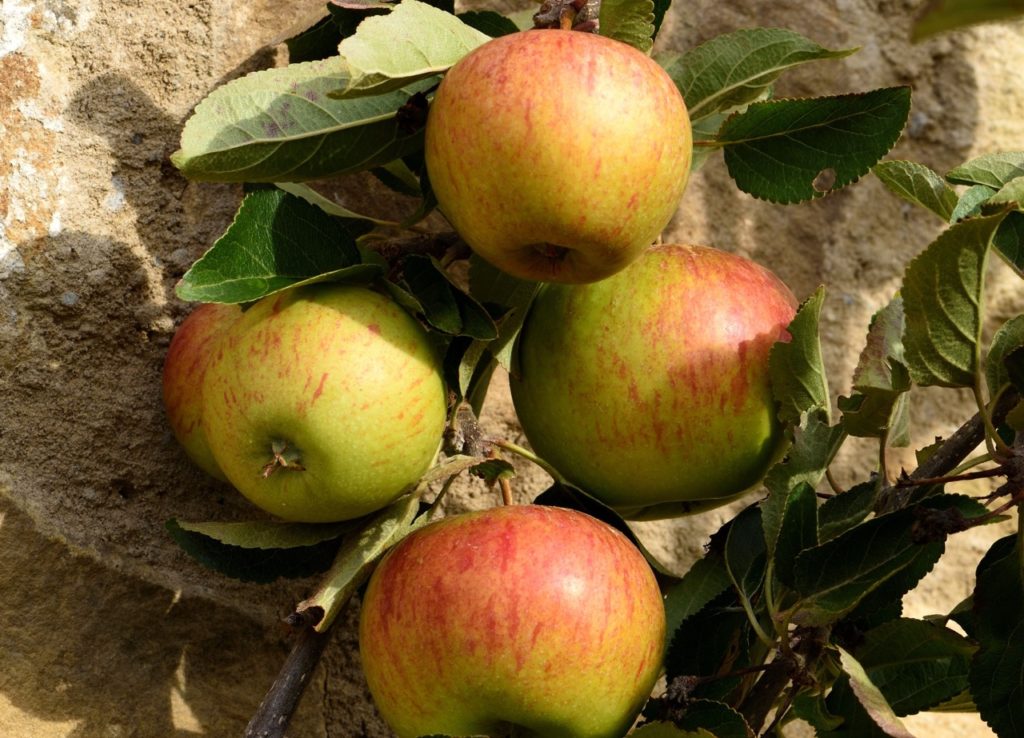
- COMMON NAME(S): apple ‘Ellison’s orange’
- FLOWERS: pink
- FRUIT: green, yellow and red
- SIZE: 4-8m in height, 4-8m spread
Said to be a good alternative to ‘cox’ for those growing in the north of England, this is an eating apple that was introduced in Lincolnshire in the early 20th century.2Apple, Ellisons Orange. (n.d.). Ashridge Nurseries. Retrieved March 9, 2023, from https://www.ashridgetrees.co.uk/ellisons-orange-apple-trees
It is a golden, red-striped apple with just a hint of aniseed that gives it a distinctive flavour.
3) M. domestica ‘Greensleeves’
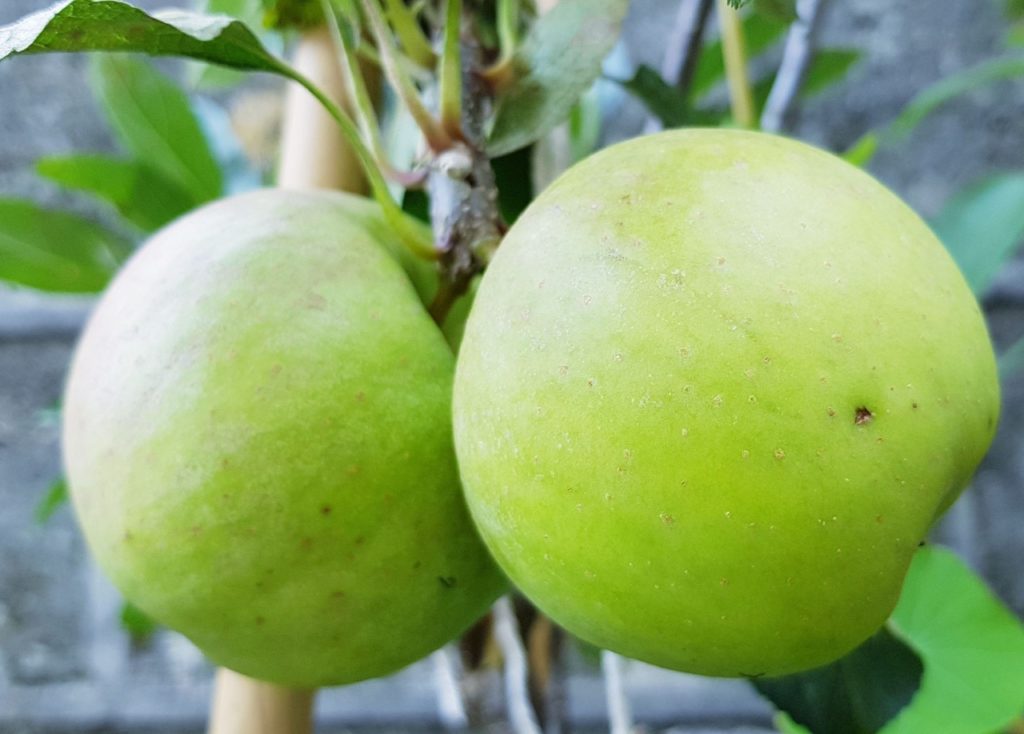
- COMMON NAME(S): apple ‘greensleeves’
- FLOWERS: pink
- FRUIT: green and yellow
- SIZE: 4-8m in height, 4-8m spread
Bred from ‘James Grieve’ and ‘Golden Delicious’, this early-fruiting variety bears regular, heavy crops of sweet golden fruits in early autumn.
Though it is self-fertile and can fruit on its own, it will perform better with the presence of a pollination partner.
4) M. domestica ‘James Grieve’
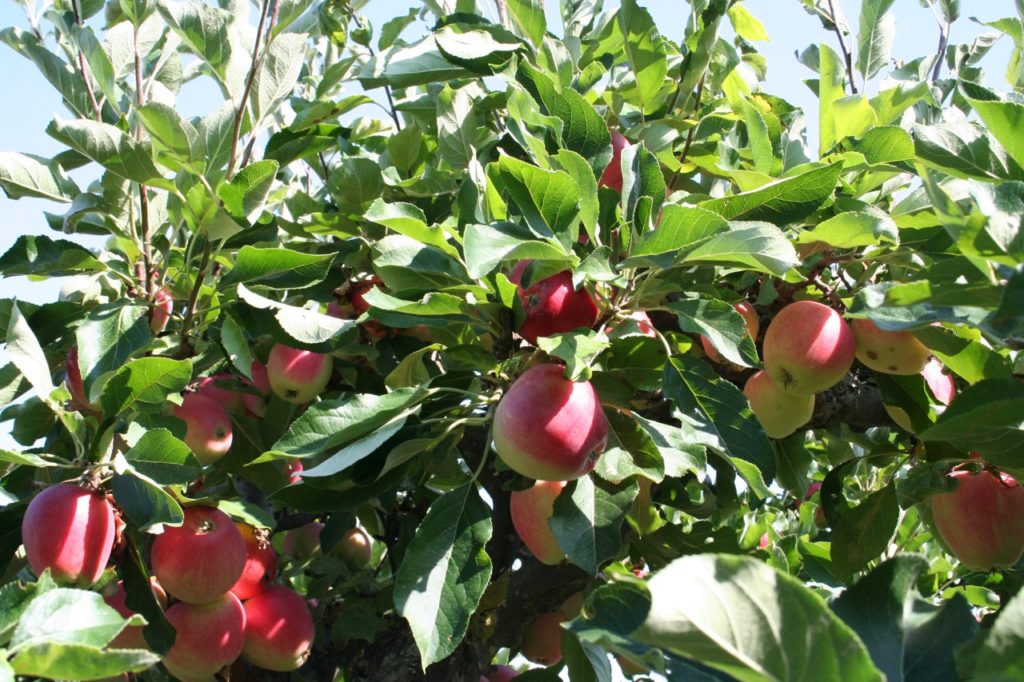
- COMMON NAME(S): apple ‘James Grieve’
- FLOWERS: white
- FRUIT: green, red and yellow
- SIZE: 4-8m in height, 4-8m spread
First introduced in Scotland in the late 19th century, this is one of the apples I myself have in my forest garden and it is one of my absolute favourites.
These are great for both cooking and eating apples, and are great for pressing, though they do not store well at all.
They are self-fertile and will fruit alone, but yield tends to be higher if another apple tree is close by.
I have a large, mature apple tree of this variety, but it is also relatively easy to keep small on the right rootstock.
5) M. domestica ‘King Of The Pippins’
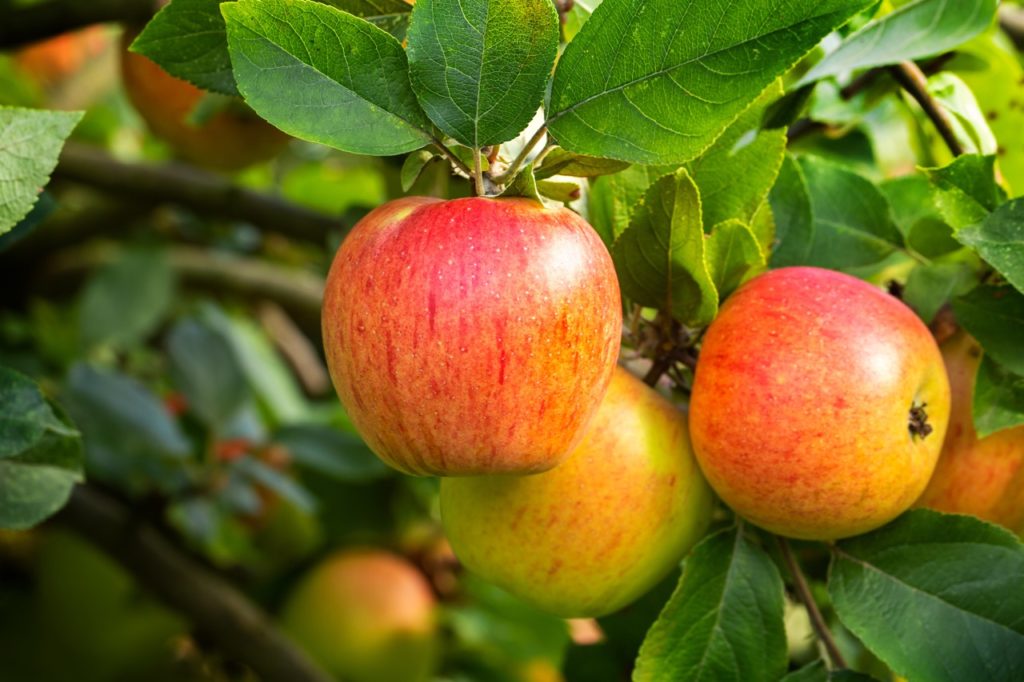
- COMMON NAME(S): apple ‘king of the pippins’
- FLOWERS: pink
- FRUIT: orange, yellow and red
- SIZE: 4-8m in height, 4-8m spread
This is a great eating or dessert apple with a sweet-sharp flavour.
It juices well, can also be cooked, and in storage, will become sweeter over time.
6) M. domestica ‘Lane’s Prince Albert’
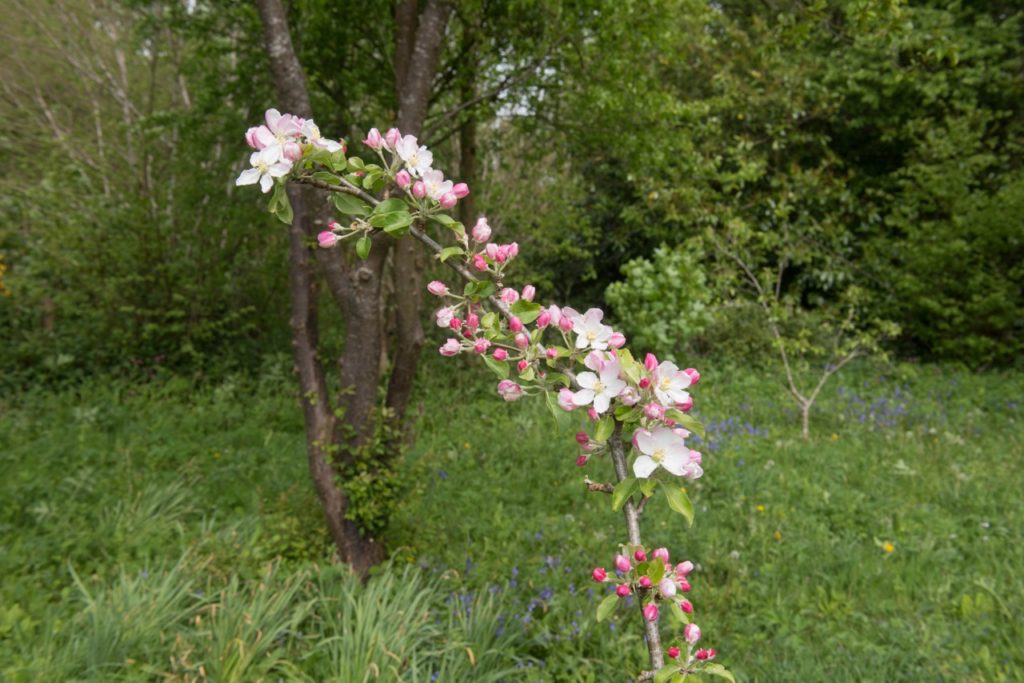
- COMMON NAME(S): apple ‘lane’s prince Albert’
- FLOWERS: pink
- FRUIT: green, orange and red
- SIZE: 4-8m in height, 4-8m spread
This is an apple variety commonly used as a cooking apple, though it stores well and sweetens over time to become a pleasant eating apple too.
Sharp and juicy, it is scab resistant and is one of the best storage apples for winter eating after Christmas.
7) M. domestica ‘Laxton’s Superb’
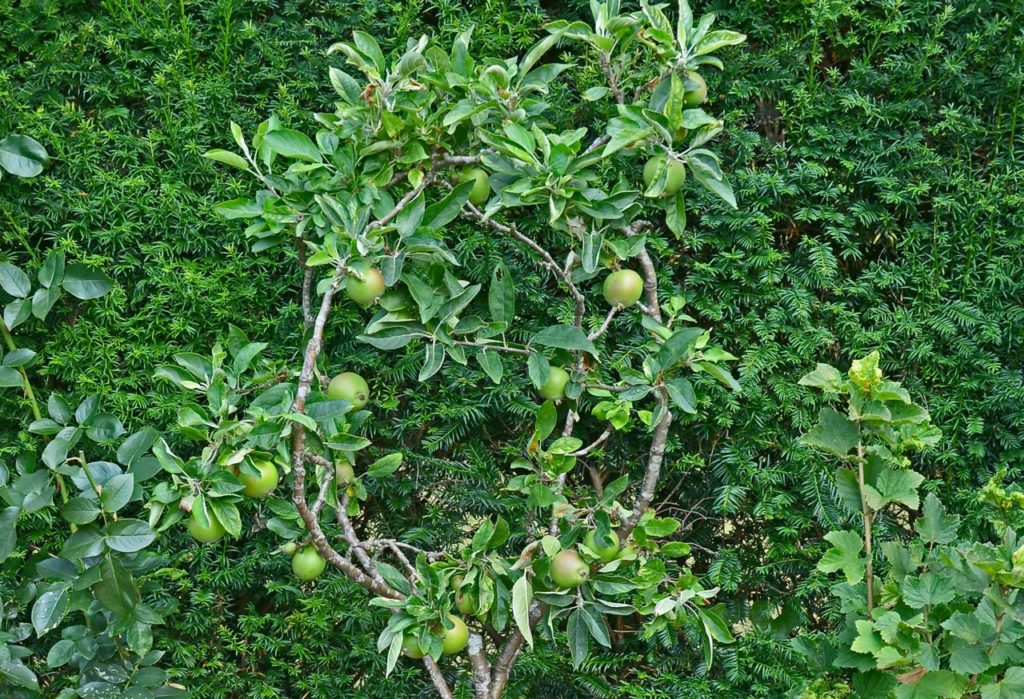
- COMMON NAME(S): apple ‘Laxton’s superb’
- FLOWERS: pink
- FRUIT: green, red and yellow
- SIZE: 4-8m in height, 4-8m spread
This is an old Victorian variety that is often said to resemble cox apples, but the fruits are larger and have a strong and appealing flavour.
It can, however, be prone to biennial bearing.
As a self-fertile apple tree, this option can be grown alone, but it does produce bigger yields when grown with other trees.
8) M. domestica ‘Red Devil’
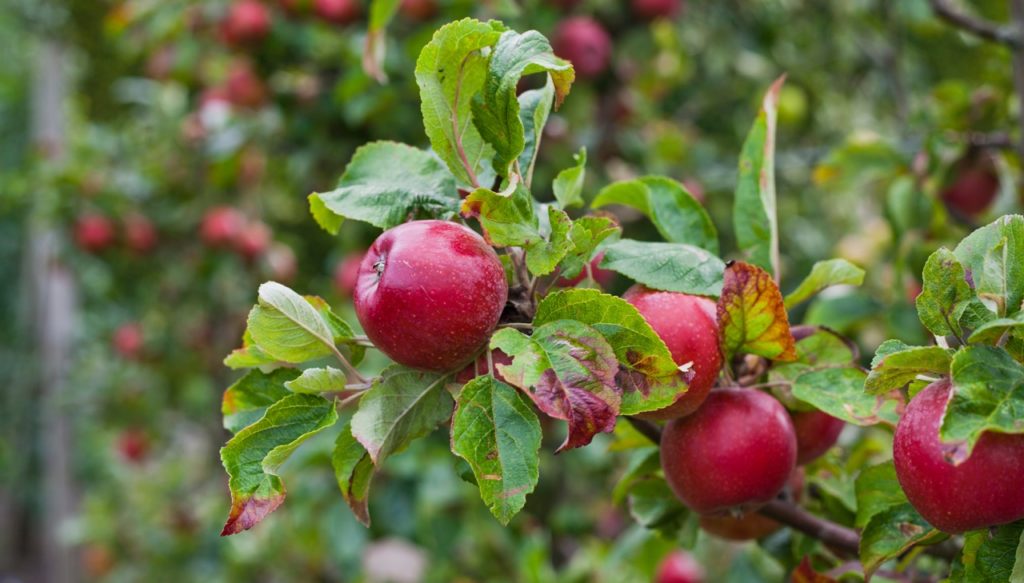
- COMMON NAME(S): apple ‘red devil’
- FLOWERS: pink and white
- FRUIT: red
- SIZE: 4-8m in height, 4-8m spread
This is a good garden variety that grows well across much of the UK.
It is fully self-fertile and is prized for its bright red colour, which is more like an intense crimson when fully ripe.
This is a mid-season cultivar which has fruits great for eating and juicing.
The red pigmentation on the skin bleeds into the flesh and a pinkish juice can be produced.
9) M. domestica ‘Red Falstaff’
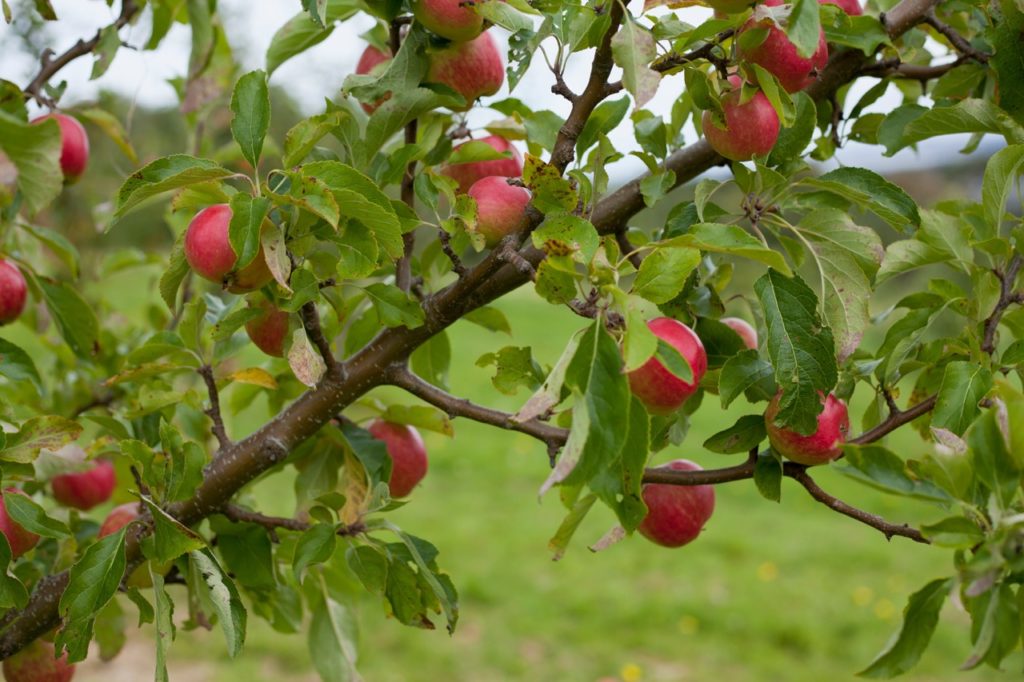
- COMMON NAME(S): apple ‘red falstaff’
- FLOWERS: pink
- FRUIT: orange and red
- SIZE: 4-8m in height, 4-8m spread
This popular garden apple variety is an eating or dessert apple that is pretty easy to grow, producing abundant yields of crisp, juicy, red-flushed fruits with a sweet flavour.
It is self-fertile but will do best when it has a pollination partner close by.
10) M. domestica ‘Red Windsor’
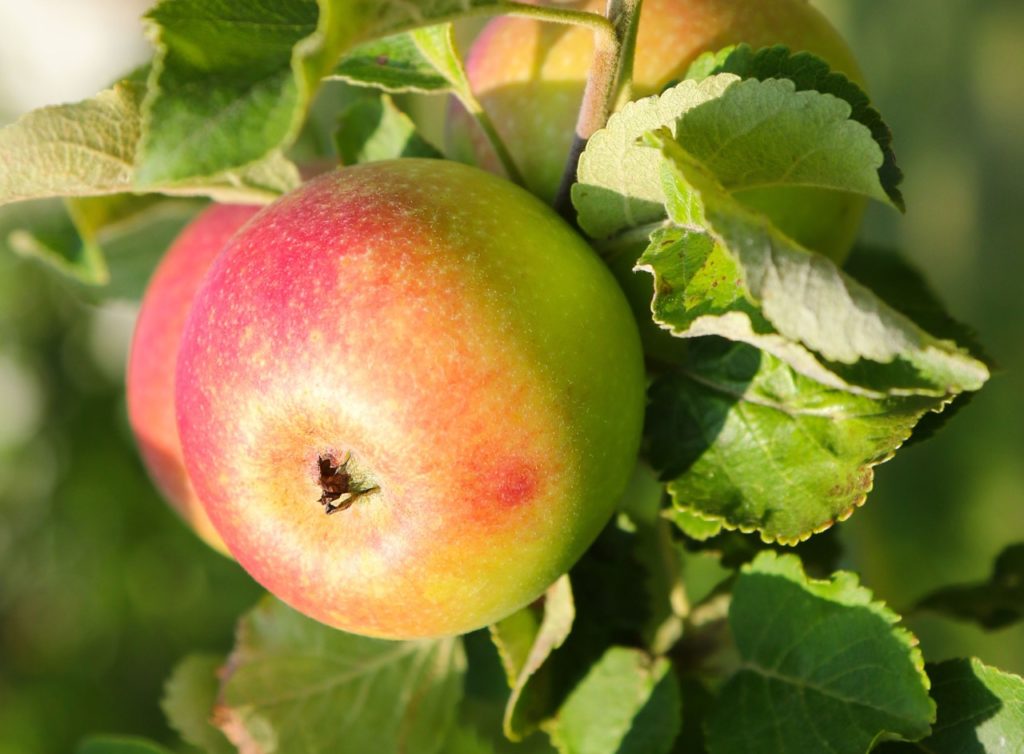
- COMMON NAME(S): apple ‘red windsor’
- FLOWERS: pink and white
- FRUIT: red
- SIZE: 1.5-2.5m in height, 1.5-2.5m spread
Introduced in Herefordshire in 1985, this is a cox-like, aromatic, eating apple.3Red Windsor Apple. (n.d.). Copyright Orange Pippin Ltd. https://www.orangepippin.com/varieties/apples/red-windsor
It is reliably self-fertile and will crop well even without another apple close by.
The apples are sweeter and more disease resistant than ‘cox’ and are suitable even for northern regions in the UK.
11) M. domestica ‘Reverend W. Wilks’
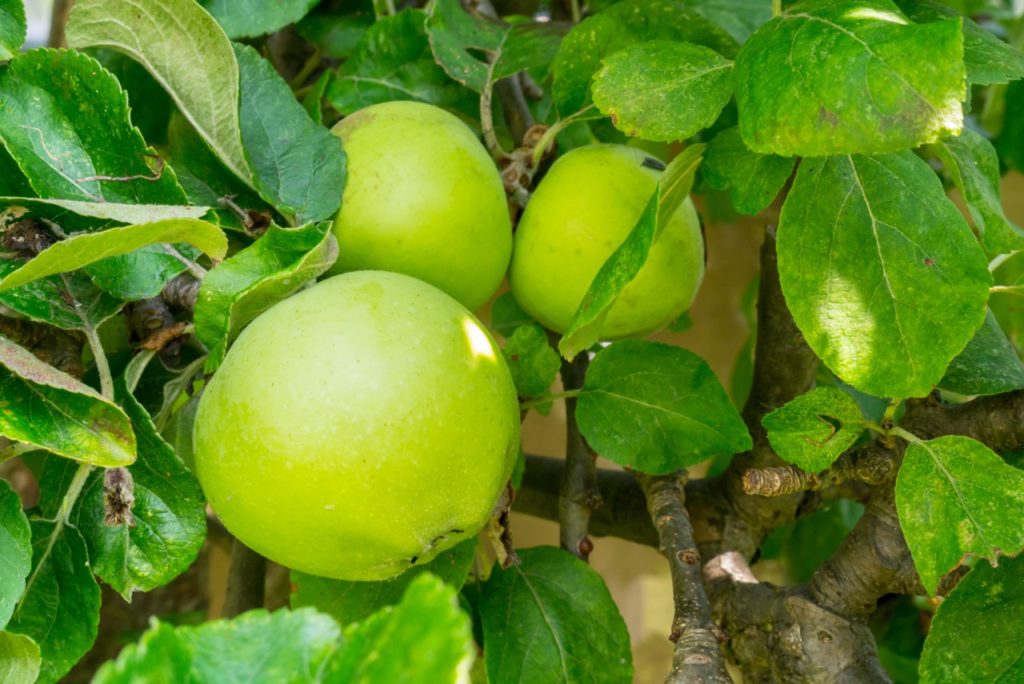
- COMMON NAME(S): apple ‘Reverend W. Wilks’
- FLOWERS: pink and white
- FRUIT: orange, red and green
- SIZE: 2.5-4m in height, 2.5-4m spread
This is a self-fertile cooking apple that is a great choice for those wanting fruits as early as summer, but it does have a tendency towards biennial bearing.
It produces a great puree when cooked with a good mix of tang and sweetness.
12) M. domestica ‘Scrumptious’
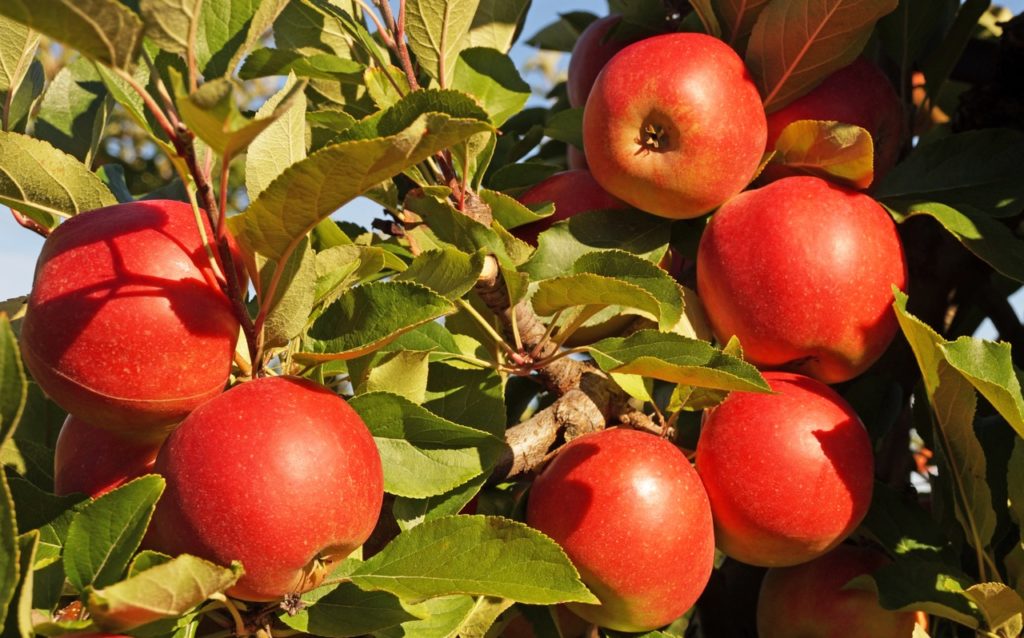
- COMMON NAME(S): apple ‘scrumptious’
- FLOWERS: pink
- FRUIT: red
- SIZE: 4-8m in height, 4-8m spread
Producing delicious honeyed apples with excellent sweet flavour, this fully self-fertile cultivar originated in Kent.4Scrumptious. (2023, March 9). Frank P Matthews. Retrieved March 9, 2023, from https://www.frankpmatthews.com/catalogue/fruit-trees/apple/scrumptious/
As well as producing tasty red fruits, it also has good disease resistance and copes well in the north and in wetter regions.
13) M. domestica ‘Spartan’

- COMMON NAME(S): apple ‘spartan’
- FLOWERS: white
- FRUIT: red
- SIZE: 4-8m in height, 4-8m spread
This is a popular dark red or purple-hued eating apple that originated in Canada in 1926.5Apple – Malus Spartan. (2022, November 9). Chew Valley Trees. Retrieved March 9, 2023, from https://www.chewvalleytrees.co.uk/products/detail/malus-spartan
It is a heavy cropper and very easy to grow, producing crisp and juicy apples with a sweet flavour.
The flavour develops as fruits remain on the tree but fades over time in storage, though these apples do keep well.
14) M. domestica ‘Sunset’
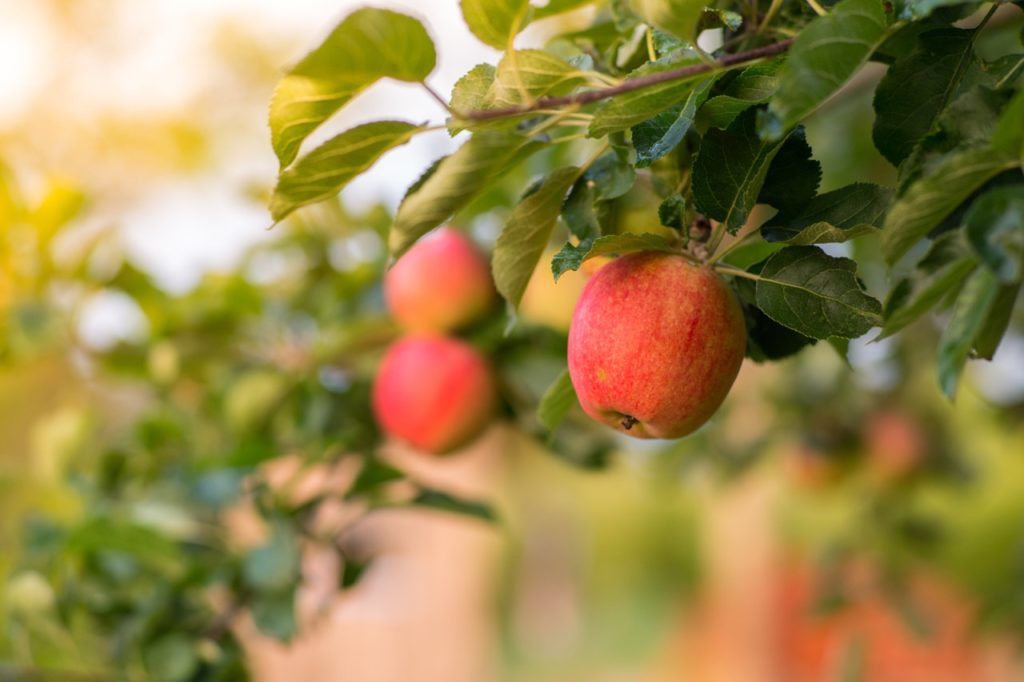
- COMMON NAME(S): apple ‘sunset’
- FLOWERS: pink
- FRUIT: green, orange, red and yellow
- SIZE: 4-8m in height, 4-8m spread
This popular eating apple variety is similar to ‘cox’ in flavour but it is easier to grow.
The fruits are relatively small but make up for their size in taste.
15) M. domestica ‘Winston’
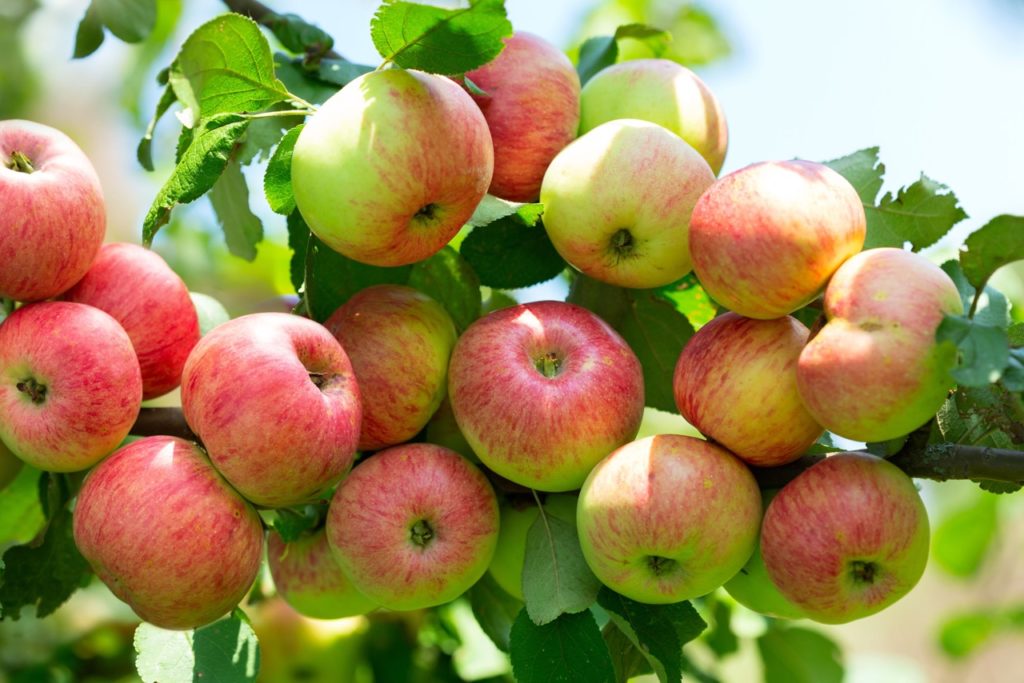
- COMMON NAME(S): apple ‘Winston’
- FLOWERS: pink
- FRUIT: red and yellow
- SIZE: 4-8m in height, 4-8m spread
This is a russet, eating apple that is excellent for storage over the winter months.
Its apples have a creamy white flesh and a tart taste that mellows over time when the fruit is stored.
References
- 1May, P. (n.d.). A Guide to Sussex Apple Varieties. A Guide to Sussex Apple Varieties. Retrieved March 9, 2023, from https://brightonpermaculture.org.uk/wp-content/uploads/fruit/sussex-apple-varieties.pdf
- 2Apple, Ellisons Orange. (n.d.). Ashridge Nurseries. Retrieved March 9, 2023, from https://www.ashridgetrees.co.uk/ellisons-orange-apple-trees
- 3Red Windsor Apple. (n.d.). Copyright Orange Pippin Ltd. https://www.orangepippin.com/varieties/apples/red-windsor
- 4Scrumptious. (2023, March 9). Frank P Matthews. Retrieved March 9, 2023, from https://www.frankpmatthews.com/catalogue/fruit-trees/apple/scrumptious/
- 5Apple – Malus Spartan. (2022, November 9). Chew Valley Trees. Retrieved March 9, 2023, from https://www.chewvalleytrees.co.uk/products/detail/malus-spartan
